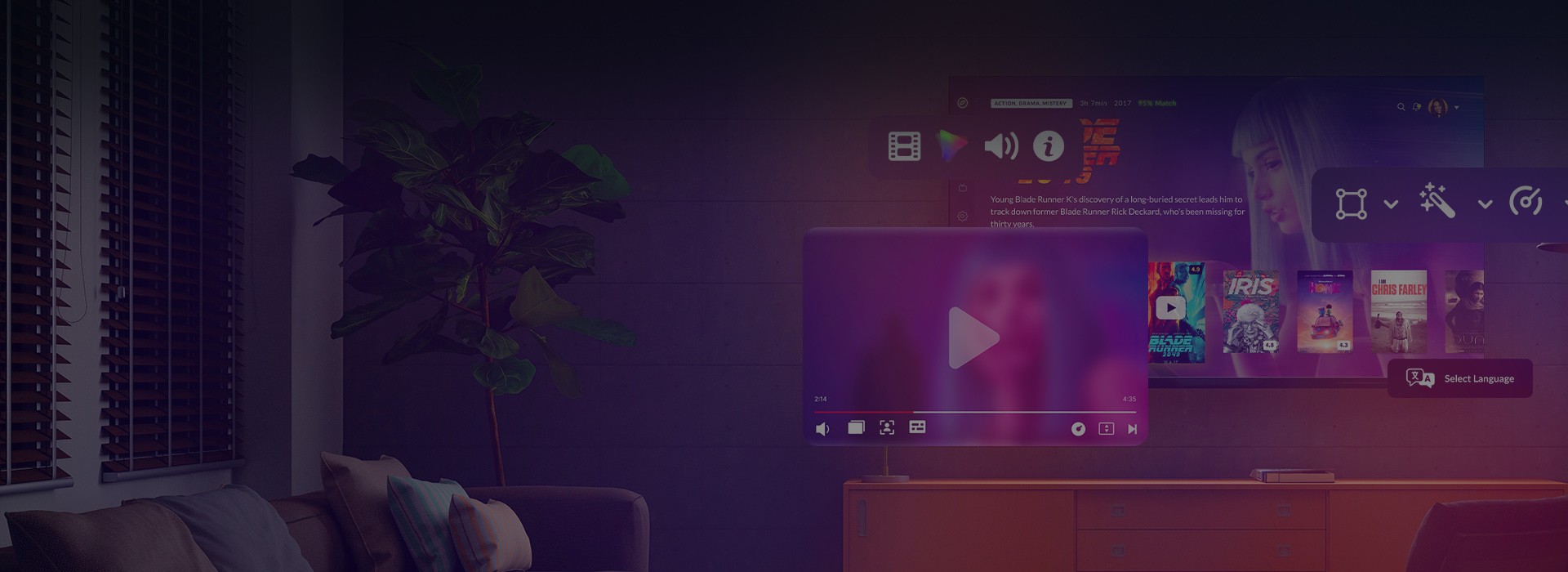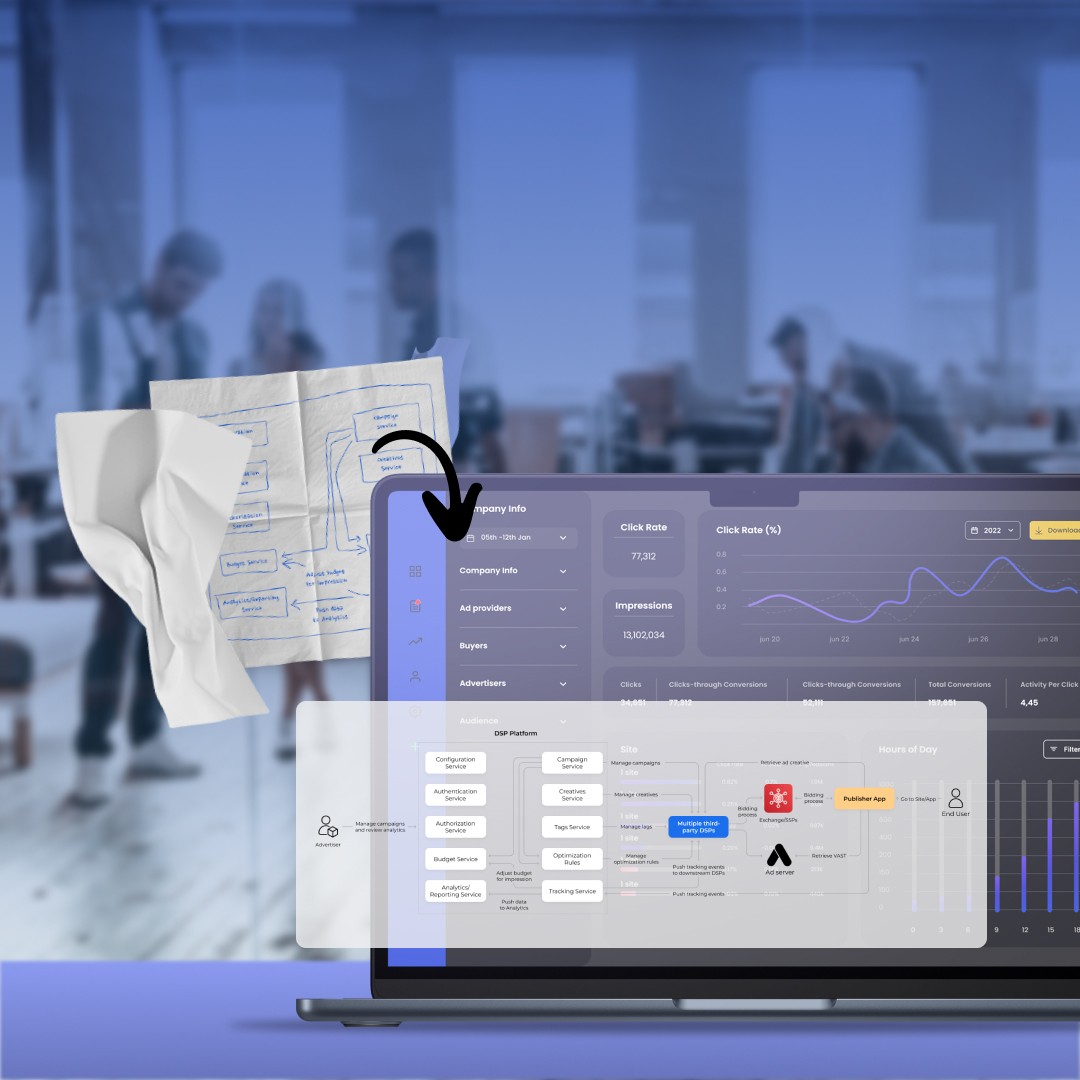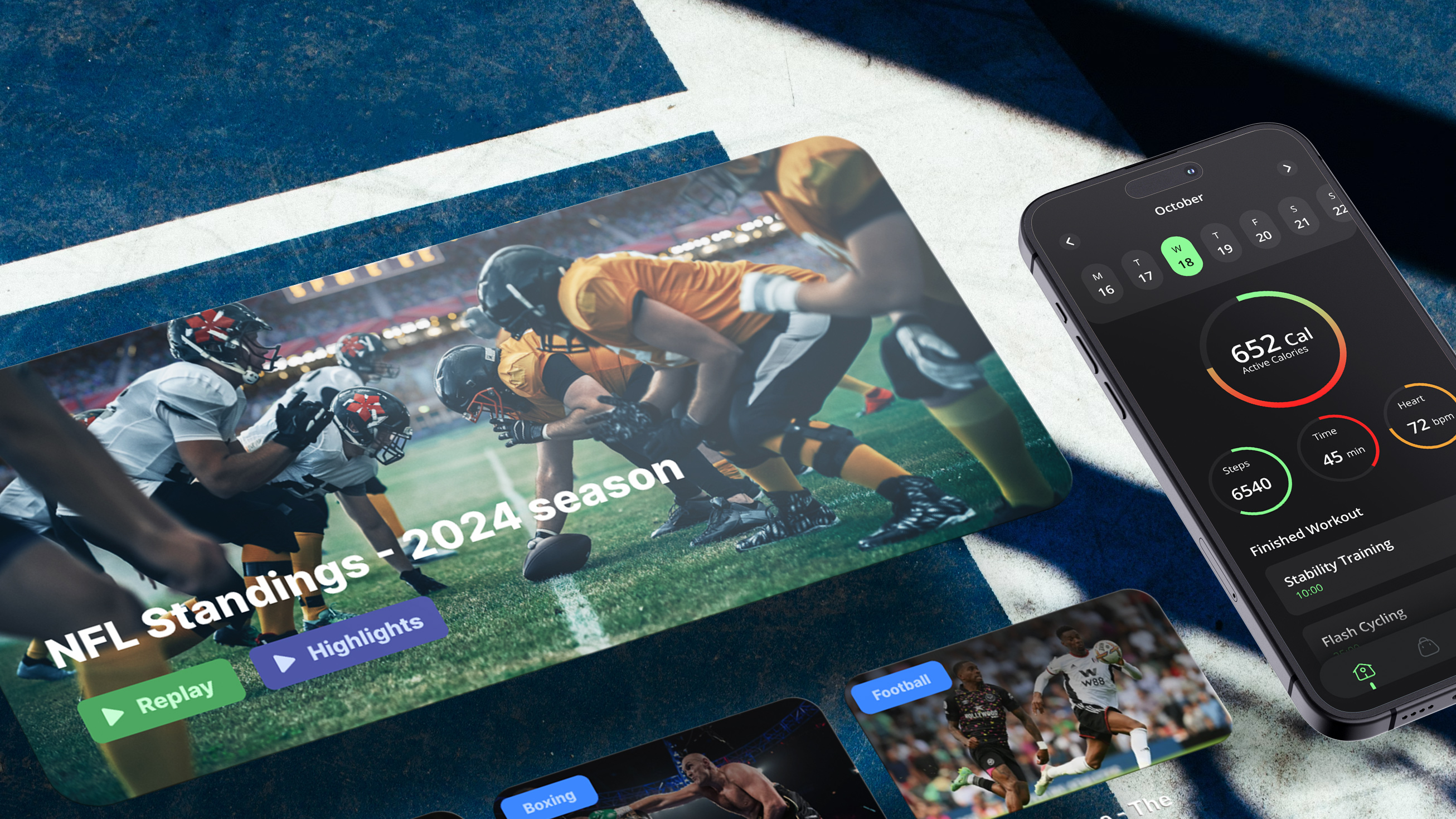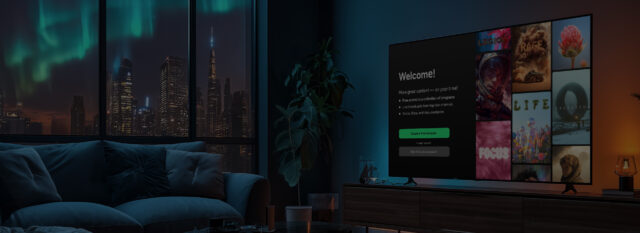Live streaming is booming, and if you’re thinking about building your own app, you’re tapping into something big. Audiences today love the immediacy, authenticity, and interactivity of live video, from sports events and gaming streams to interactive webinars. But creating a successful live streaming experience involves more than just hitting “go live”.
Let’s walk through the essentials of live streaming app development, exploring why live video is so powerful, what opportunities it offers broadcasters and VOD providers, and the crucial tech and UX considerations that can benefit or hurt your application. We’ll also answer common questions such as how to develop a live streaming app, highlight key benefits of live streaming, and discuss the specifics of developing such an app. Time to break it down.
Why live streaming matters for viewers
Live streaming isn’t just a passing occurrence. It’s changing the way people connect with content. Here’s why it resonates so strongly with modern audiences:
Built-in urgency and authenticity
Live streams happen in real time, which gives them a “you have to be there” vibe. Whether it’s a product drop, game reveal, or behind-the-scenes Q&A, viewers show up because they don’t want to miss the moment. According to Stream Hatchet’s 2024 report, global live-stream hours watched jumped 12% year over year, reaching 32.5 billion hours — a clear sign that people crave live, unedited experiences.
Deeper engagement through participation
Live video turns viewers into participants. They can react instantly, post comments, respond to polls, and even influence what happens next, from picking a winner in a contest to asking questions during a live webinar. This back-and-forth interaction is what keeps people watching. It’s more than viewing, it’s being part of something as it unfolds.
Trust through transparency
Because live video is raw and unedited, it feels more honest. No fancy post-production, no script polishing — just real-time, human content. That builds trust. DemandSage reports that live-stream viewership in Q1 2024 was 128% higher than in Q1 2019, showing sustained growth driven by this authenticity factor.
Massive, mainstream reach
Live streaming isn’t just for gamers or influencers anymore; it’s everywhere. From e-commerce and education to entertainment and politics, live video spans industries. In fact, DemandSage estimated the global live-streaming market reached $99.8 billion in 2024 and is projected to hit $345 billion by 2030. That’s not niche, that’s dominant, and only growing in 2025.

If you’re curious about how this evolution is playing out across industries, Oxagile explored it further here — from audience expectations to monetization trends.
In short, live streaming gives viewers what they want: real-time energy, interaction, and a sense of closeness to the action. For any app hoping to capture and retain attention, delivering those elements is no longer optional — it’s expected.
Benefits of live streaming for broadcasters and VOD Platforms
Live streaming offers broadcasters and VOD platforms powerful ways to grow and engage audiences:
For existing broadcasters
Traditional broadcasters (TV networks, news channels, sports leagues) use live streaming to engage digital-native viewers beyond cable TV. Interactive features like live chats, polls, and multi-camera angles encourage active participation, keeping audiences watching longer.
For example, Oxagile partnered with a national satellite TV provider to launch a highly scalable second-screen app with synced stats, live predictions, and interactive chat during soccer matches. The app supported up to 500,000 concurrent users and rewarded fans for accurate game predictions, significantly boosting live engagement and repeat viewership.
For VOD platforms
For platforms primarily offering video-on-demand, live streaming unlocks new monetization paths, driving subscriptions, pay-per-view revenue, and advertising around live events. Amazon Prime and Netflix have successfully used live sports and special events to attract new subscribers and increase engagement.
However, implementing live streaming requires addressing technical challenges such as robust infrastructure, low-latency streaming, and reliable moderation tools.
Done correctly, the benefits of live streaming, including greater audience engagement and new revenue streams, far outweigh these challenges. That’s why many platforms choose to develop live streaming apps with support for both VOD and real-time content.
What makes a good live streaming app: tech and UX perks
Behind every smooth viewing experience is a well-thought-out live video streaming development strategy — from the right protocols to smart UX choices.
Viewers expect live streaming to feel seamless: HD quality, instant playback, smooth interaction, and zero glitches. But delivering that experience takes more than just good bandwidth. A truly successful live streaming app combines technical resilience with thoughtful UX.
Let’s look at the features that set the best apps apart.
1. High-quality viewing with adaptive streaming
Laggy or pixelated video is a deal-breaker. That’s why solid live streaming apps use adaptive bitrate streaming — a technology that automatically adjusts video quality based on a user’s internet speed and device performance.
If someone’s connection weakens mid-stream, the app lowers video resolution to avoid freezing, then switches back up as the signal improves. This ensures smooth, uninterrupted viewing.
Protocols like HLS and MPEG-DASH support this out of the box, and platforms like Wowza and AWS IVS offer built-in tools to make implementation easier.
But quality isn’t just about visuals, it’s also about latency. In live trivia apps or sports betting, even a two-second delay can throw everything off. That’s where Low-Latency HLS and WebRTC come in. These protocols help minimize delay between what’s happening and what the user sees — critical for real-time interactivity.
Case in point: Scalable simulcasting built in 10 weeks — for every screen, every fan
A global horse racing brand partnered with Oxagile to launch a live simulcasting solution with multi-camera support and ultra-low latency. The challenge? Delivering high-quality streams across mobile, web, and smart TVs under a tight 2.5-month deadline.
What we delivered:
- Multi-camera live races from several venues
- Instant HD replays and VoD content
- Synchronized mobile, Roku, Apple TV, and Fire TV apps
- Seamless delivery via AWS Elemental, Akamai, and Streamroot
The result was a smooth, reliable streaming experience that scaled to thousands of concurrent viewers on any device.
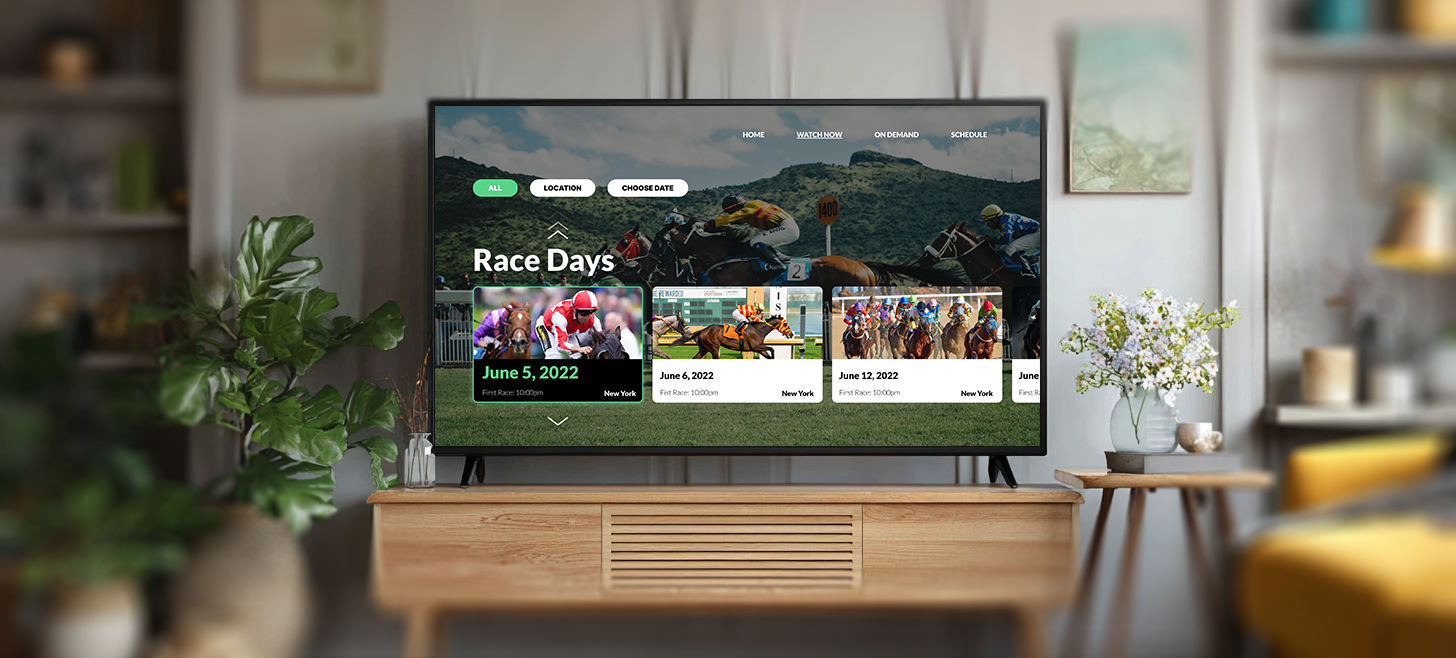
2. Protecting your live streams (security & DRM)
When it comes to premium content — live sports, concerts, conferences, or exclusive shows — stream protection isn’t optional. Piracy, signal hijacking, and unauthorized access can quickly turn a high-value broadcast into a liability. That’s why secure delivery must be baked into your live streaming architecture from day one.
A robust app typically includes:
- HTTPS and AES encryption to protect content in transit
- Multi-DRM (Multi–Digital Rights Management) systems like Widevine, FairPlay, or PlayReady to restrict copying and enable cross-device playback
- Geo-blocking and account-level verification to enforce content licensing rules
- Tokenized URLs and session watermarks to trace and block unauthorized restreams
- Hardened APIs to protect against spoofing or injection attacks
Our hands-on know-hows
We’ve helped clients protect high-value live streams using multi-DRM systems paired with session-based watermarking — a particularly critical setup in sports streaming, where events are live, time-sensitive, and rights-protected.
Want a deeper dive into why DRM is essential for sports broadcasts and how to implement it right?
Read: Leveraging Multi-DRM for Safe Sports Streaming
3. Monetizing live streams: FAST, SVOD, AVOD, TVOD & Ads
Live streaming isn’t just about engagement, it’s also a revenue engine. The best platforms support flexible monetization strategies, often mixing several models:
- FAST (Free Ad-Supported Streaming TV): Linear-style channels with ad breaks, like Pluto TV
- SVOD (Subscription Video on Demand): Monthly access to live streams or premium events
- AVOD (Advertising Video on Demand): Free content monetized via ads, either injected by the app (CSAI) or stitched directly into the stream (SSAI)
- TVOD (Transactional Video on Demand): One-time payments for special live events (e.g., a concert, boxing match, or product launch)
- Shoppable Streams & Sponsorships: Viewers buy products during a stream, or see branded overlays and integrated offers
- Analytics Integration: View-through rates, engagement stats, ad impressions — all tracked in real time for optimization
Case in point: A telecom giant’s ad strategy — tailored, scalable, effective
Oxagile doesn’t just implement monetization logic, we also help clients choose the right model based on their business goals and target markets. For a major European telecom operator with a VOD service, we developed a custom ad module that supported both free and premium content. It integrated seamlessly with the client’s ecosystem and enabled flexible monetization across user segments.
If you’re looking for a strategic overview, our experts also shared four proven OTT business models, along with insights into how to combine them effectively.
By combining development expertise with industry insight, we help clients find and implement monetization strategies that scale without compromising UX.

4. Driving engagement with interactive features
Viewers today expect to be part of the stream, not just watching from the sidelines. Interactivity is what makes live content feel alive.
Here are features that bring viewers in:
- Live chat and emoji reactions give the stream a communal vibe
- Polls, quizzes, and Q&As encourage direct input from the audience
- Gamification, such as live giveaways or points-based challenges, boosts retention
- Multi-camera control allows viewers to choose their own angle (great for sports, concerts, or events)
- Real-time overlays can display stats, maps, bios, or social feeds layered over the video
- Social sharing and co-watching let viewers invite friends or sync playback across screens
Case in point: Turning TV viewers into active fans
Oxagile helped a national satellite TV provider create a second-screen app that brought live sports to life.
While matches streamed on the big screen, fans used their phones to vote on outcomes, chat in real time, and track live stats — all synced with the broadcast.
The platform handled up to 500,000 concurrent users and turned routine matchdays into interactive fan experiences.
5. AI-powered features
AI is becoming a silent powerhouse in live streaming, working behind the scenes to improve both performance and personalization.
Key applications include:
- Highlight generation: AI detects exciting moments (goals, spikes in sound/movement) and auto-creates clips for replay or sharing
- Smart metadata & content tagging: Useful for search, personalization, and post-stream navigation
- Moderation tools: Flag offensive messages in real-time chat or detect copyright violations mid-stream
- Ad placement optimization: AI learns where users are most likely to drop off and inserts ads during low-impact moments
- Real-time translation or subtitles: For global audiences, especially in multi-language events
- AR/VR overlays: Add interactive or immersive elements during the stream — think live player stats or commentary layers
Case in point: Real-time highlights for fans and content teams
For a sports tech provider, Oxagile built an AI-powered solution that automatically compiles key match moments sucha as goals, saves, and red cards, into short highlight reels.
These clips are delivered to users within seconds, ready to watch or share, keeping fans engaged even after the final whistle.
The system not only enhances fan experience but also gives media teams ready-to-publish social content in real time.

6. Multi-platform broadcasting support
A great app doesn’t care where your audience watches, it just works. Today’s users might start watching on a phone, continue on a laptop, and cast to their TV, all in one session. Your live streaming platform needs to be ready.
Must-have platform support includes:
- Mobile apps (iOS/Android): Optimized for variable bandwidth and mobile UI
- Web players: Cross-browser, fast-loading, HTML5-based
- Smart TV and CTV apps: Native or hybrid apps for Roku, Apple TV, Android TV, Fire TV, Samsung, and more
- Casting & syncing: Support for Chromecast and AirPlay, with seamless stream handoff
- Consistent UX: Same content, branding, and feature logic across all platforms
Case in point: Expanding a music streaming platform to Roku
To help a leading music streaming provider grow its presence in the U.S., Oxagile developed a custom Roku app tailored to the American audience’s strong preference for the platform.
We built a slick, responsive interface optimized for remote control navigation, integrated it with the client’s existing video backend, and ensured seamless playback for both live streams and VoD content.
With Roku’s massive U.S. user base, the app gave the client an effective new channel to reach and retain viewers.
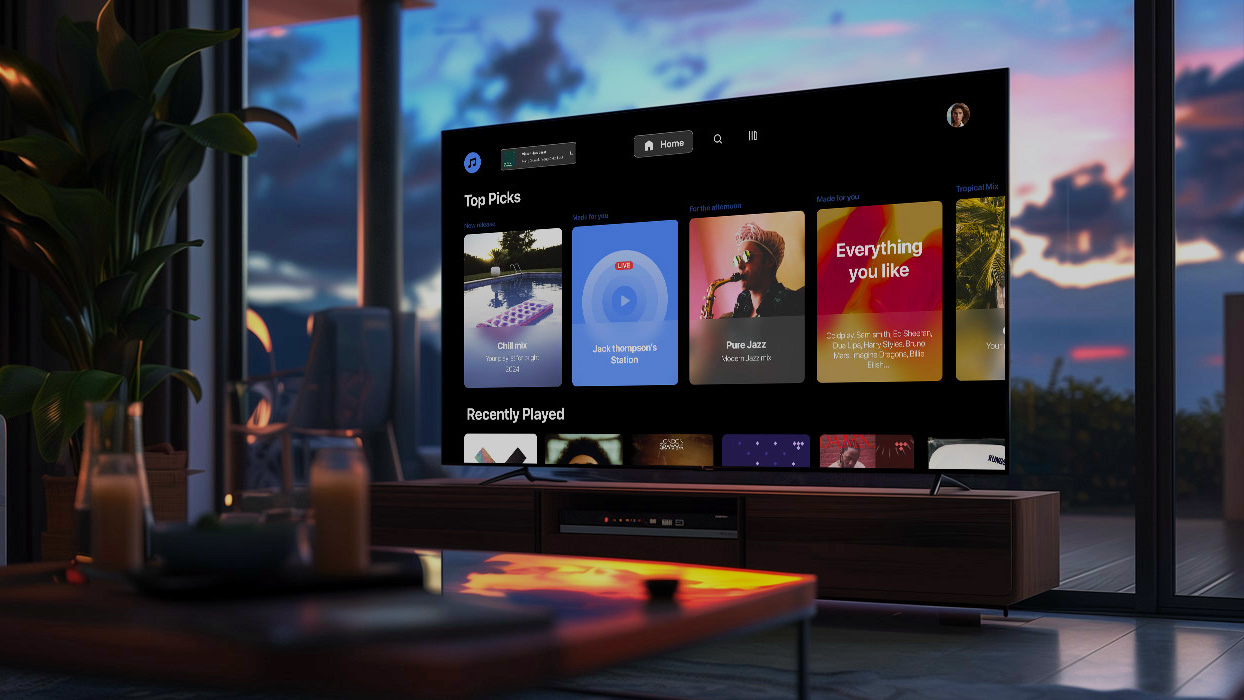
There’s a reason so many platforms, from niche fitness instructors to global broadcasters, are betting on live streaming — it works. Not just because it’s trendy, but because it taps into something people genuinely want right now: real-time connection, relevance, and interaction.
That said, building a good live streaming app isn’t just about pressing “Go Live”. It’s about knowing what your viewers expect and then quietly doing a lot of technical heavy lifting to make it all feel seamless.
From adaptive video delivery to ad stitching, from chat moderation to camera switching, the path to great live streaming app development is full of choices that affect both performance and user experience. Add in real-time analytics, AI-generated highlights, or custom monetization layers, and you’ve got more than a video stream — you’ve got a living product.
Whether your goal is to develop live streaming app features for a brand-new platform or add real-time content to an existing VOD setup, the foundation is the same: think beyond the video. Think community. Think cross-device. Think retention.
Because the real benefits of live streaming aren’t just in view counts, they’re in moments that feel personal, participatory, and worth showing up for.
Live streaming done right starts with the right tech
If your goal is real-time engagement, crystal-clear delivery, and revenue that scales, we can help you build the kind of app today’s viewers expect. From backend architecture to interactive UX, we’ve got the experience to make it work.

